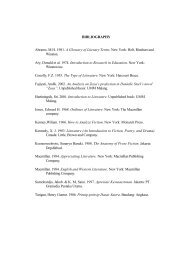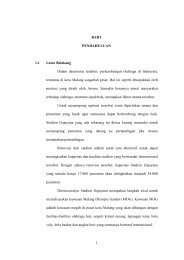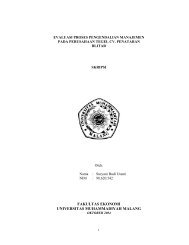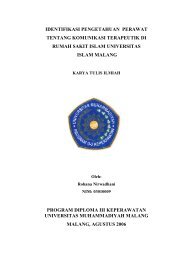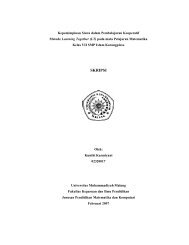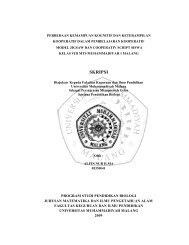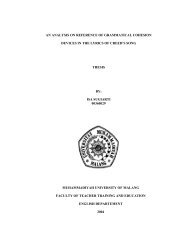File : THESIS.pdf - Universitas Muhammadiyah Malang
File : THESIS.pdf - Universitas Muhammadiyah Malang
File : THESIS.pdf - Universitas Muhammadiyah Malang
Create successful ePaper yourself
Turn your PDF publications into a flip-book with our unique Google optimized e-Paper software.
Assessment Objective Weighting<br />
%<br />
A Knowledge with understanding<br />
B Handling information and solving<br />
problems<br />
This gives a general idea of the allocation of marks to assessment objectives A and B in<br />
the theory papers. However, the balance on each paper may vary slightly. Fifteen percent<br />
of the total marks will be awarded for awareness of the social, economic,<br />
environmental and technological implications and applications of Biology. These<br />
will be awarded within the ‘Knowledge with understanding’ and the ‘Handling<br />
information and solving problems’ categories.<br />
Teachers should take note that there is a greater weighting of 55% for skills (including<br />
handling information, solving problems, practical, experimental and investigative skills),<br />
compared to the<br />
45% for knowledge and understanding. Teacher’s schemes of work and the sequence of<br />
learning activities should reflect this balance, so that the aims of the syllabus may<br />
be met, and the candidates prepared for the assessment.<br />
Additional Information<br />
Modern Biological Sciences draw extensively on concepts from the physical sciences.<br />
It is desirable, therefore, that by the end of the course, candidates should have a<br />
knowledge of the following topics, sufficient to aid understanding of biological systems,<br />
but no questions will be set directly on them.<br />
• The electromagnetic spectrum<br />
• Energy changes (potential energy, activation energy and chemical bond energy)<br />
• Molecules, atoms, ions and electrons<br />
BIOLOGY 9700 A/AS LEVEL<br />
• Concentration and molarity<br />
• Acids, bases, pH and buffers<br />
• Isotopes, including radioactive isotopes<br />
• Oxidation and reduction<br />
• Hydrolysis and condensation<br />
Mathematical and Statistical Requirements are laid out later in the syllabus<br />
STRUCTURE OF THE SYLLABUS/ STRUKTUR SYLLABUS<br />
The Subject Content of the syllabus is divided into an AS and A2. The A2 includes a core<br />
and an<br />
Applications of Biology section, which is studied, in its entirety, by all A2 candidates.<br />
The subject content for the Core and the Applications syllabuses is presented as<br />
learning outcomes. The examination will assess the candidate’s knowledge and<br />
understanding of these.<br />
This structure is shown below.<br />
Assessment Components<br />
1 The Core syllabus – there are sixteen sections.<br />
AS Level candidates will study and be assessed on the first eleven sections,<br />
A to K. A Level candidates will study and be assessed on all twenty one<br />
45<br />
PAPERS 1, 2 and 4<br />
32 PAPERS 1, 2 and 4<br />
C Experimental skills and investigations 23 PAPERS 3 and 5<br />
113



